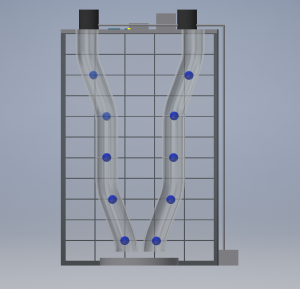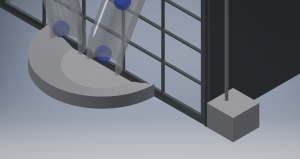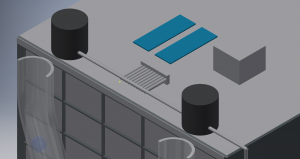When considering a project it is important to have a full understanding of both its costs and benefits. What utility is the project providing its financier and over what time horizon? In the case of the Acopian art stairs project, the benefits mostly exist as positive externalities and the costs as both upfront and recurring expenses.
There have been found to be many positive externalities that will benefit the college, incentivizing the initial investment. First and foremost, public art has many positive psychological effects on viewers. It can build community, enhance and enrich man-made environments, help cope with anxiety, and even provide a greater level of consciousness, not to mention, happiness and joy (Bach, 2006, p. 27-28). Students that are in a higher state of psychological well-being will overall perform better on schoolwork. If there is an artwork in Acopian that provides, joy and could potentially relieve anxiety, it is likely that students will have greater mental functioning, and therefore a greater capacity to excel in their studies. Better performance from students would increase the college’s statistics, and therefore their rankings within the colleges of the country. With better rankings comes an increased ability to entice future students to enroll in the college, bringing in more revenue for the school.
The college also hopes to increase its size, in order to receive the increased revenue that is associated with a greater enrollment of students (Tatu, 2016). However, there is a large push back from local residents against the college’s expansion (Tatu, 2016). One of the many benefits of public art on college campuses is that it has been shown to “positively affect the local economies” (Landi 2012, 24). If the college could help to improve the local economy through a public art installation, town-gown relations would likely be less tense. If it could be shown that the college is actually benefiting the local residents, they might be less resistant to the desired expansion. The college would then be able to increase its size and bring in the desired extra revenue to complete other needed projects.
Public art can also be used to “embody and reflect the intellectual and creative missions of the institution” (Landi, 2012, 23). An artwork that showcases the principles and values of the Lafayette educational experience would be intriguing to potential students. Such an artwork could be a big selling point to prospective students, and would effectively advertise the interdisciplinary nature that Lafayette prides itself on. The artwork would be a physical, concrete example of the college’s blending of liberal arts and education, as opposed to simply parroting it on tours. It would be a testament to future students that Lafayette is the sort of school that promotes innovation, and would help to bring in more applicants, driving the acceptance rate to new levels. The college would receive greater prestige, and a greater desire for students to attend, which in turn would bring in more tuition payments. Greater prestige for the college would also mean better futures for graduates. Employers would be more likely to higher Lafayette graduates if the acceptance rate was lowered, and the college subsequently received higher rankings. As alumni further progress within their careers and have a higher likeliness of being hired, and making larger salaries. With more expendable income, alumni would be more likely to donate to the school in the future, once again providing the college with more economic gains.
To acquire the benefits of a public art installation, the school will need to fund mostly upfront costs. These costs will generally fall under the category of materials, parts, construction, or labor. For the purposes of this proposal, the main focus will be on materials and parts. Construction and labor costs would be a reasonable next step for future iterations of this project.
The nature of this art installation means that a majority of its costs will be upfront. These costs will generally fall under the category of materials, parts, construction, or labor. For the purposes of this proposal, the main focus will be on materials and parts. Construction and labor costs would be a reasonable next step for future iterations of this project.
The main cost of this installation will stem from the large half cylinder that will run down the length of Acopian and support the glass orbs. At this time the cost of the half pipe and its casting are yet to be determined. We suggest the the next phase of this project investigate the costs of associated with casting the half pipe, building its structural supports, and maintaining the structure itself.

CAD Drawing: Glass orbs, metal rods, plastic casting.
Another significant source of cost will be the glass orbs suspended within the large half pipe. These orbs are intended to be approximately 2 feet across. They are expected to be made using colored/stained glass, which is $10.50 per square ft (“Home Depot,” 2017). The costs of covering the surface area of one orb would be 4*π*10.5= $131.95. That should be the extent of the cost since the labor is intended to be done by students and the binding material is considered to be a negligible cost in this context. In this estimation, 10 orbs are being utilized, which would leave the cost at $1,319.50. The rods pinning these orbs to the plastic casting would be 4’ long, 1.5’’ diameter. At a cost of $52.25 per rod, these metal parts would have a total cost of $522.50 (“Metals Depot.” 2017)

CAD Drawing: Water collection system and pump.
An important source of expense is the water and electricity system. The heart of the water system, a ⅛ hp hydraulic pump with a voltage of 110V or 220V and a cost of $160 (“Spaguts,” 2017). The pump will be charged by two 265 watt solar panel with a combined cost of $730 (“Delphi Glass,” 2017). The energy generated by the solar panel will be stored in a 1.2 kWh solar energy storage module. The storage module has a cost slightly greater than $1227.79 (“MG Solar-Shop,” 2017). Another major cost of the water system is the storage container for the accumulated water. A 500 gallon plastic water storage tank costs about $359 (“Plastic-Mart,” 2017). A similar cost will be affixed to the water basin that will be catching rainwater.

CAD Drawing: Solar panels, rain barrels, and storage module.
Also, we intend to modify the windows of Acopian with a decal or etching. The intention is to create an imprint that will cast a shadow representing a tributary system. There are a number of ways to achieve this effect, however most of them are fairly expensive. One of the cheaper options is to use window decals in order to create the desired effect. One decal can cover a singular Acopian window (43’’x68”) at a cost of $136.50. This alternative would cost a significant amount if any large area were to be covered. For example, to alter the windows on either side of the half pipe would require about 30 decals. This would cost $2,490 and may not have the desired effect since the decals would have to be identical (“Signazon,” 2017). If the decals are individually designed the cost would be $4,095. Future groups should consider if it is worth the increased costs to have a better, more aesthetic design.
These upfront costs give a reasonable picture of what the materials and parts for Acopian Art Stairwell project will cost. All together these estimated costs add up to $7366.79. It should be noted that these are purely the costs of materials for only a portion of the most expensive alternative. This estimate does not include labor, support structures, half pipe castings, and smaller hardware items.

The majority of the expense of this project will be the upfront costs, however there will also be reoccurring costs. These reoccurring costs will take the form of cleaning, replacement of parts and other general maintenance. Not all parts will require cleaning but certain parts will at different time intervals once the project has been installed.
Elements installed along the wall that will need certain maintenance include the casts, technicolor orbs, and the decals. The plastic casts will need to be cleaned once a semester from bird poop and other things sticking to it over time. They can be cleaned with simply soap and water. The plastic casts should last as long as they don’t crack and scratches can be fixed with either drilling a hole or injecting methylene chloride into the crack. After ten years, it is possible that the plastic will start to yellow in which case they would need to be replaced (Emco Industrial Plastics, 2017). The technicolor orbs will also need to be cleaned once a semester due to bird droppings, leaves, sticks or other things that could get caught in them or between the orbs and the cast. It is possible that the glass could break and shatter due to birds running into them and then they would need to get the glass replaced. If part of the orb shatters it would need to be unhinged from the caste and brought down to be fully evaluated and then replaced depending on how much of it breaks. Yet if they remain intact, which they should, then they would just need to be washed with soap and water to allow for clear exposure. The decals will be attached to the outside of the window and will need to be cleaned and properly maintained by washing them. The decals typically last around 3 years so they will need to be replaced more frequently if they start to un-stick. They are not re-positionable once placed on the window so they will need to be placed on carefully to avoid misplacement. The decals are also easy to remove and would only need window cleaner and a sharp edge to scrape off (Signs.com, 2017).
Maintenance for the drainage swale would mostly come in the form of making sure that is clear from debris that would restrict the flow of water (Popular Mechanics, 2017). This would mean upkeep of any plants that are installed to absorb water, and could easily be carried out by Lafayette Facilities crews.
The required cleaning and maintenance will require the company hired by Lafayette to come when they would normally clean the windows and then clean installation. This will add to the overall recurring costs of the project.
A key factor of the economic analysis and developmental success of this project is the source of funding for this project. Since this project will be in Acopian and will also include the art department, we will be looking for funding from these disciplines. Scott Hummel, director of engineering, told us that he has funds for projects similar to ours that are interdisciplinary. He told us that if we come to him with a strong proposal then he would be willing to fund this project. He didn’t specify the amount of funds he would be able to allocate; therefore, we also would consider proposing this project to alumni and also President Bylery. We would propose the project in terms of three stages. The first being our cheapest option that would only include the glass decals. This would give the possible donors insight into what the final product would look like and wouldn’t require too much funding. We would then discuss with financiers the second and third installation over a five-year period. This way the funds wouldn’t have to come all at once, especially if Scott Hummel is given more funding annually then we could use grant funds for different years. The five-year plan would also allow for a more in-depth analysis of the second and third stages and would allow the project to reach its full potential by the end of the five years.
